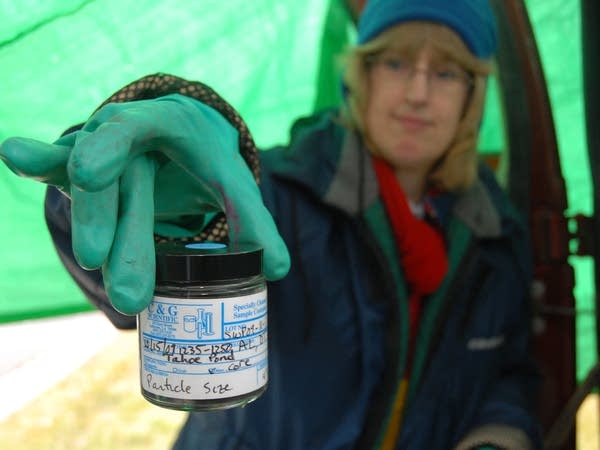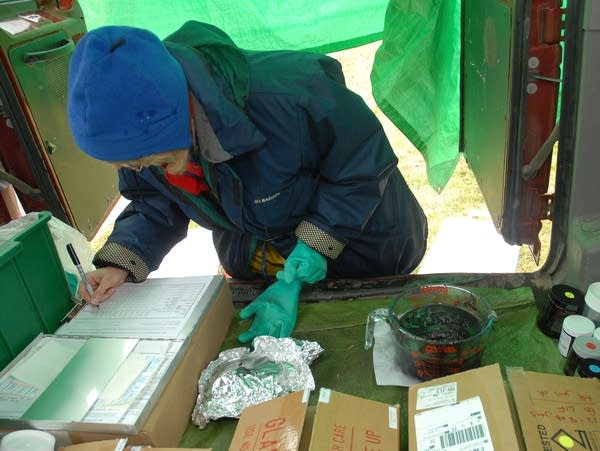New concerns raised over blacktop sealant runoff

A long-standing ritual of homeowners - sealing their blacktop driveways - is getting new scrutiny from the state of Minnesota because sealant from driveways and parking lots may be washing off into ponds and streams as hazardous waste.
About 30 years ago, environmental regulators had an idea: they could keep ground water cleaner by damming up runoff from streets, parking lots and other places, and letting pollutants settle out before the water ran into lakes and streams.
Stormwater retention ponds started showing up all over the place, and they work. There are now about 20,000 of them in the Twin Cities. Trouble is they work a little too well, as they were meant to collect contaminants like fertilizer runoff.
Dale Thompson runs the Minnesota Pollution Control Agency's Municipal Stormwater Unit and was helping test a pond off Tahoe Road in Woodbury.
Create a More Connected Minnesota
MPR News is your trusted resource for the news you need. With your support, MPR News brings accessible, courageous journalism and authentic conversation to everyone - free of paywalls and barriers. Your gift makes a difference.
"Probably it's only recently that we started to get a little concerned about everything else that might be going along with the typical nitrogen and phosphorus that we would expect to be in and the particles, and the sand and grit that we would expect to be coming off the roads," Thompson said. "We started to see some other things showing up."
One of those things is PAH, or polycyclic aromatic hydrocarbons. They're formed during combustion, and health experts believe they can cause cancer. You've probably cooked up some yourself -- they're in the charred part of grilled meat.
But the stuff in storm water ponds isn't coming from barbequed chicken.

A lot of it is likely coming from coal tar. That's a byproduct of cooking coal to make coke, a fuel commonly used in steelmaking. Coal tar is used in products ranging from dandruff shampoo to blacktop sealant.
Millions of gallons of the sealant have been painted on parking lots, driveways and trails for decades. It's supposed to protect asphalt from sun, gasoline and oil.
The trouble is that the sealant doesn't stay put.
Judy Crane is the Minnesota Pollution Control Agency water quality scientist tracking down PAH. By kayak, she takes mud samples from the bottoms of storm water ponds to look for these and other chemicals.
Crane was in Woodbury on a recent rainy day, looking at a pond that drains into Carver Lake, a popular swimming spot. It's surrounded by homes with asphalt driveways.

"There [are] different kinds of PAHs that we're looking at," she said. "We're looking at metals, and we're looking at some endocrine-disrupting compounds with octylphenols, nonylphenols and nonylphenol ethoxylates. There's like this whole big list."
PAH has been under increased scrutiny for most of the last decade, after a U.S. Geological Survey study found the contaminant in a Texas stream. They matched the chemical fingerprint to coal tar sealants.
So what should regulators do about the problem? There are three options.
The first is to do nothing.
Don Taylor is a Texas-based board member of the National Pavement Contractors Association and one of the nation's most outspoken defenders of coal tar. He's questioned whether it's a health hazard, and said it might be environmentally better to preserve existing asphalt.
"Side by side, all things being equal, it will wear longer on the pavement, in general," Taylor said. "It protects your asphalt better. It's a good product."

And Taylor said coal tar on is its way out anyway as sealcoaters are switching to cheaper, asphalt-based coatings.
Which brings us to strategy number two: getting rid of coal tar.
Opponents say it doesn't really work, and some stores, including Lowe's and Home Depot, have stopped selling it.
Austin, Texas, and Madison, Wisconsin, have banned it. And some Minnesota legislators say they'll propose a state ban on using coal tar in asphalt sealants in the next legislative session.

State Rep. Bev Scalze, a DFLer from Little Canada, sponsored the state funding for the study now underway by the MPCA. While Scalze supports a ban, she said prohibitions on specific products can be difficult to pass. But she hopes people will rethink their home maintenance habits, anyway.
"We've still got to get people to stop using coal tar on their driveways, and getting used to an asphalt driveway that's not solid black," Scalze said.
And finally, something has to be done with the PAH already out there.
PAH contamination means mud from storm water ponds is technically a hazardous waste. That means cities and counties won't be able to clean out ponds with a backhoe and use the mud somewhere else.
On the other hand, putting all the mud in a hazardous waste landfill could cost hundreds of millions of dollars. University of Minnesota scientists are studying ways to clean up PAH. A fungus that grows in wood compost may break down the contaminants.
In the meantime, the state will stop using coal tar on roads next summer. The tests being done this fall will tell if more action is needed to clean up Minnesota's storm water ponds.
